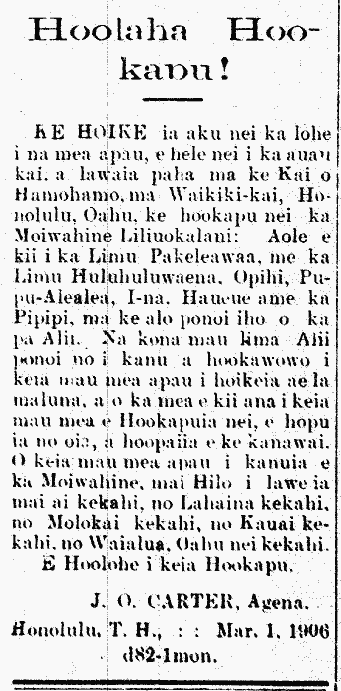HOLD CLOSING EXERCISES ON CHAPEL LAWN
Three Departments of Kamehameha Join in Commencement Tomorrow Eve.
Joint commencement exercises will be held on the Bishop Memorial chapel lawn at 8 o’clock tomorrow evening by the Kamehameha Manual school, Kamehameha Girls’ school and the Kamehameha Preparatory school.
Song, “Hawaiian Hymn,” choir.
Invocation, Rev. J. L. Hopwood.
Response, “O Savior of the World,” Girls’ Glee Club.
Song, “Kaahumanu,” Boys’ Glee Club.
Address, “The Power That Makes for Living,” Rev. George Laughton.
Presentation of candidates for and awarding of diplomas and certificates.
Hawaii Ponoi.
Benediction.
Following is a list of the candidates and their courses:
English—Sarah Ahin, Ah Moe Akana, Annie Akiu, Tillie Brandt, Elizabeth Ellis, Elizabeth Kamanoulu, Mary Kanewanui, Emily Keapo, Edith Koki, Tillie Peller, Eva Saffery, Phoebe Wilcox.
Dressmaking—Rosalind Mokumaia.
Electrical Work—John Ah Chong, William Akana, Hiram Anahu, Charles Kamakawiwoole.
Machine Shop—Edward Akiu, Alfred Amasiu, Clarence Blake, Arthur Irvine, Charles Mock Sing.
Painting—John Gibson.
Carpentry—Obed Kaikaka, Joseph Wright, Ioane Kanakaole, Samuel Keliinoi, William Keliinoi.
Candidates for special certificates:
Machine Shop—Godfrey Bertelmann.
Electrical Work—Harry Bertelmann, Abraham Kaapana.
Forging—Louis Kamaha.
Candidates for promotion from the boys’ preparatory school:
William Coelho, Charles Dudoit, Harry Kaahea, Daniel Kanuha, Edward Like, Edward Worthington.
[Congratulations to the class of 2016! Make Pauahi proud!!]
(Star-Bulletin, 6/8/1916, p. 8)

Honolulu Star-Bulletin, Volume XXIII, Number 7537, Page 8. June 8, 1916.





